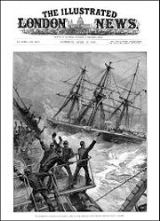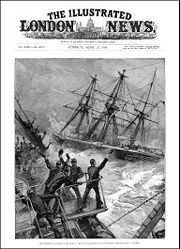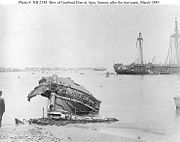
1889 Apia cyclone
Encyclopedia
The 1889 Apia cyclone was a Pacific tropical cyclone
, which swept across Apia, Samoa
on March 15, 1889 during the Samoan crisis
. The effect on shipping in the harbour was devastating, largely because of what has been described as 'an error of judgement that will forever remain a paradox in human psychology'.
. In order to be ready should such an opportunity arise, both nations had dispatched squadrons to the town to investigate the situation and act accordingly. A British ship was also present, ostensibly to observe the actions of the other nations during the Samoan upheavals.
During the days preceding the cyclone of the 15th, increasing signs were visible of the impending disaster. March was cyclone season in this area, and Apia had been hit by a cyclone just three years previously, which the captains of the ships heard about from local people, especially as the weather began to change and the atmospheric pressure
began to fall. The captains were experienced Pacific seamen, as were many members of their crews, and they all saw the approaching signs of impending disaster, just as they knew that the only chance they had of riding out the 100 mi/h winds was to take to the open sea.
Apia is an exposed harbour, unprotected by high ground or an enclosing reef. The northern part of the harbour is open to the Pacific, and thus wind and waves can sweep through the area and drive any shipping which remained in the bay onto the reefs at the Southern end, or toss them right up the beach. However, even though the officers of the various navies were well aware of the necessary procedures in the face of such a threat, none made a move. This has been attributed to jingoism
or national pride; none of the men in the harbour were willing to admit in front of the other nations' navies, that they were afraid of the elements, and so refused to take precautions, and refused to allow the merchant ships which accompanied them to move either, leaving thirteen ships, some larger vessels, at anchor close to one another in Apia harbour.


When the cyclone struck the result was catastrophic. The local people had taken themselves to safety well before the storm struck, but the ships in the bay only began to evacuate at the very last minute, and thus were crowding towards the entrance to the bay when the hurricane hit. Only escaped, making less than one knot; she dragged herself to the open sea, despite being less than six feet from a reef at one point. Once out at sea she was easily able to ride out the ensuing winds. Her survival is attributed to her size (2,227 tons) and her more powerful and modern engines, built only five years before, as compared to the ten or twenty years for many of the other ships.
As for the other ships, chaos reigned in the harbour. The was tossed against the beach in the afternoon, dragged back into the sea and wrecked on a reef at 10pm that evening, although the majority of her crew survived unhurt and were able to participate in the ensuing rescue operation. was smashed into the same reef in the early afternoon, and her surviving crew spent a miserable day and night clinging to her rigging before being rescued, by which time 43 of her complement had drowned. The was thrown high on the beach with eight of her crew missing or dead and her internal systems totally wrecked. She would however later be refloated and eventually reconstructed in Hawaii
.
The German ships fared much worse. The SMS Olga came off best, thrown high onto the beach where she was wrecked but many of her crew survived, escaping onto higher ground. The SMS Adler and SMS Eber
were less fortunate, because they were caught at the harbour mouth by the initial blow and were bodily picked up and smashed together before sinking in deep water. 96 men from their crews drowned in the storm, and both ships were totally destroyed. All six of the merchant ships remaining in the harbour were wrecked, and the death toll was well over 200 sailors from several nationalities.
The incident is often cited as a clear example of the dangers of putting national pride before necessity, especially in the face of natural disaster
. The incident did not blunt the Pacific ambitions of any of the imperial powers involved in the disaster. However, the Germans and British continued to make territorial gains amongst the Samoan islands and New Guinea, whilst the United States focused on the Philippines
and Micronesia
, although more care was taken to respect the weather phenomena of the Pacific from this point on.
Tropical cyclone
A tropical cyclone is a storm system characterized by a large low-pressure center and numerous thunderstorms that produce strong winds and heavy rain. Tropical cyclones strengthen when water evaporated from the ocean is released as the saturated air rises, resulting in condensation of water vapor...
, which swept across Apia, Samoa
Samoa
Samoa , officially the Independent State of Samoa, formerly known as Western Samoa is a country encompassing the western part of the Samoan Islands in the South Pacific Ocean. It became independent from New Zealand in 1962. The two main islands of Samoa are Upolu and one of the biggest islands in...
on March 15, 1889 during the Samoan crisis
Samoan crisis
The Samoan Crisis was a confrontation between the United States, Germany and Great Britain from 1887–1889 over control of the Samoan Islands during the Samoan Civil War. At the height of the confrontation three American warships, Vandalia, USS Trenton and USS Nipsic were wrecked along with the...
. The effect on shipping in the harbour was devastating, largely because of what has been described as 'an error of judgement that will forever remain a paradox in human psychology'.
The growing storm
Events ashore had led to upheaval in the Pacific nations and colonies. Both the United States and Imperial Germany saw this as a potential opportunity to expand their holdings in the Pacific through gunboat diplomacyGunboat diplomacy
In international politics, gunboat diplomacy refers to the pursuit of foreign policy objectives with the aid of conspicuous displays of military power — implying or constituting a direct threat of warfare, should terms not be agreeable to the superior force....
. In order to be ready should such an opportunity arise, both nations had dispatched squadrons to the town to investigate the situation and act accordingly. A British ship was also present, ostensibly to observe the actions of the other nations during the Samoan upheavals.
During the days preceding the cyclone of the 15th, increasing signs were visible of the impending disaster. March was cyclone season in this area, and Apia had been hit by a cyclone just three years previously, which the captains of the ships heard about from local people, especially as the weather began to change and the atmospheric pressure
Atmospheric pressure
Atmospheric pressure is the force per unit area exerted into a surface by the weight of air above that surface in the atmosphere of Earth . In most circumstances atmospheric pressure is closely approximated by the hydrostatic pressure caused by the weight of air above the measurement point...
began to fall. The captains were experienced Pacific seamen, as were many members of their crews, and they all saw the approaching signs of impending disaster, just as they knew that the only chance they had of riding out the 100 mi/h winds was to take to the open sea.
Apia is an exposed harbour, unprotected by high ground or an enclosing reef. The northern part of the harbour is open to the Pacific, and thus wind and waves can sweep through the area and drive any shipping which remained in the bay onto the reefs at the Southern end, or toss them right up the beach. However, even though the officers of the various navies were well aware of the necessary procedures in the face of such a threat, none made a move. This has been attributed to jingoism
Jingoism
Jingoism is defined in the Oxford English Dictionary as extreme patriotism in the form of aggressive foreign policy. In practice, it is a country's advocation of the use of threats or actual force against other countries in order to safeguard what it perceives as its national interests...
or national pride; none of the men in the harbour were willing to admit in front of the other nations' navies, that they were afraid of the elements, and so refused to take precautions, and refused to allow the merchant ships which accompanied them to move either, leaving thirteen ships, some larger vessels, at anchor close to one another in Apia harbour.
The cyclone


When the cyclone struck the result was catastrophic. The local people had taken themselves to safety well before the storm struck, but the ships in the bay only began to evacuate at the very last minute, and thus were crowding towards the entrance to the bay when the hurricane hit. Only escaped, making less than one knot; she dragged herself to the open sea, despite being less than six feet from a reef at one point. Once out at sea she was easily able to ride out the ensuing winds. Her survival is attributed to her size (2,227 tons) and her more powerful and modern engines, built only five years before, as compared to the ten or twenty years for many of the other ships.
As for the other ships, chaos reigned in the harbour. The was tossed against the beach in the afternoon, dragged back into the sea and wrecked on a reef at 10pm that evening, although the majority of her crew survived unhurt and were able to participate in the ensuing rescue operation. was smashed into the same reef in the early afternoon, and her surviving crew spent a miserable day and night clinging to her rigging before being rescued, by which time 43 of her complement had drowned. The was thrown high on the beach with eight of her crew missing or dead and her internal systems totally wrecked. She would however later be refloated and eventually reconstructed in Hawaii
Hawaii
Hawaii is the newest of the 50 U.S. states , and is the only U.S. state made up entirely of islands. It is the northernmost island group in Polynesia, occupying most of an archipelago in the central Pacific Ocean, southwest of the continental United States, southeast of Japan, and northeast of...
.
The German ships fared much worse. The SMS Olga came off best, thrown high onto the beach where she was wrecked but many of her crew survived, escaping onto higher ground. The SMS Adler and SMS Eber
SMS Eber (1887)
The SMS Eber, a 735-ton iron-hulled gunboat, was built at Kiel, Germany for gunboat diplomacy in the Pacific. It was a barque-rigged auxiliary steamer. After commissioning in September 1887 she was sent to the Pacific to serve in the German Colonial Empire. She disarmed the inhabitants of Nauru in...
were less fortunate, because they were caught at the harbour mouth by the initial blow and were bodily picked up and smashed together before sinking in deep water. 96 men from their crews drowned in the storm, and both ships were totally destroyed. All six of the merchant ships remaining in the harbour were wrecked, and the death toll was well over 200 sailors from several nationalities.
The incident is often cited as a clear example of the dangers of putting national pride before necessity, especially in the face of natural disaster
Natural disaster
A natural disaster is the effect of a natural hazard . It leads to financial, environmental or human losses...
. The incident did not blunt the Pacific ambitions of any of the imperial powers involved in the disaster. However, the Germans and British continued to make territorial gains amongst the Samoan islands and New Guinea, whilst the United States focused on the Philippines
Philippines
The Philippines , officially known as the Republic of the Philippines , is a country in Southeast Asia in the western Pacific Ocean. To its north across the Luzon Strait lies Taiwan. West across the South China Sea sits Vietnam...
and Micronesia
Micronesia
Micronesia is a subregion of Oceania, comprising thousands of small islands in the western Pacific Ocean. It is distinct from Melanesia to the south, and Polynesia to the east. The Philippines lie to the west, and Indonesia to the southwest....
, although more care was taken to respect the weather phenomena of the Pacific from this point on.
Ships
| United States | wrecked-1 dead | |
| United States | beached & repaired, 8 dead | |
| United States | wrecked, 43 dead | |
| British | survived storm | |
| German | beached & repaired | |
| SMS Eber SMS Eber (1887) The SMS Eber, a 735-ton iron-hulled gunboat, was built at Kiel, Germany for gunboat diplomacy in the Pacific. It was a barque-rigged auxiliary steamer. After commissioning in September 1887 she was sent to the Pacific to serve in the German Colonial Empire. She disarmed the inhabitants of Nauru in... |
German | wrecked & sunk, 73 lost |
| German | wrecked & sunk, 96 dead |

